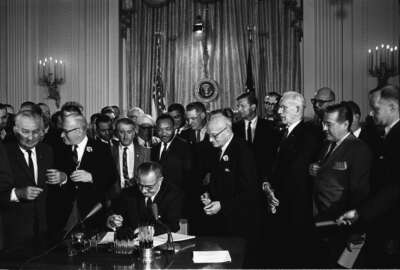
Time for a reminder KISS
Agency reorg plans overlook something obvious.
Sometimes, even the federal government can be easy to deal with.
I got my first senior thing last weekend. It’s a lifetime pass for admission to National Park Service facilities. It cost only $10. But the price goes up to $80 after August 28th. The NPS reports so much demand ahead of the congressionally-mandated price hike, it’s run out of passes in some locations.
Undaunted, I headed with my wife (who is not yet “senior” enough for this benefit) to the Great Falls location in McLean, Virginia. I was prepared for the worst. I brought my driver’s license, Global Entry card, passport, birth certificate, and two letters from certified physicians. Just kidding. I didn’t bring the birth certificate. The letters don’t exist.
After waiting in a car line for about 15 minutes, I handed over a $20 bill and my Global Entry card, requesting a senior pass. Thirty seconds later the ranger in the little booth handed me a credit card sized pass and a $10 bill. Yippee, I thought, I’m a senior!
You can order online if you live far from an NPS location that sells the passes. But otherwise, for $10 you get a pass and a visit to a nice park. Bring your hiking flip flops.
As government agencies contemplate how they’ll offer more digital services, managers should keep one principle in mind: Keep it simple. Maybe the ranger checked my Global Entry card against databases to see if I was a terrorist or felon. Or maybe he ran a check against the Social Security data. Whatever, to me it was simple. Like a credit card transaction, it was fast and the mechanics invisible.
For that matter, obtaining the Global Entry card — a far more complex process — felt reasonably simple. It did require about 20 minutes online. Then a week or so wait. Then a visit to a Customs and Border Protection/Transportation Security Administration office. And finally a couple of weeks wait for the card.
Beyond digital services, a more turbulent discussion is occurring in agencies. They’re finalizing their plans with the White House now. From what we’ve seen out of the White House, one important objective of the re-org is saving money.
As our Meredith Somers reports, among the think tanks you’ll find no shortage of reorganization ideas. Eventually these plans get wound up with politics and what Congress will go along with.
In some ways this activity looks like a bunch of pastry chefs running around the kitchen, scrounging in the cabinets for sugar. Yet there’s a 10-pound sack sitting right on the counter.
For reorganizers that 10-pound sack is the Government Accountability Office’s reports on fragmentation, overlap and duplication. One just came out in April. Simply doing what GAO recommends has the virtues of saving serious money and having an indirect congressional imprimatur.
It would leave for another day the more politically fraught questions that require debate. Like whether to continue with the Consumer Financial Protection Bureau. Or whether to slash down the number of State Department special envoys.
Agencies don’t need an 18-month fire drill to find ways of reducing waste and duplication when there’s a ready list waiting.
Copyright © 2025 Federal News Network. All rights reserved. This website is not intended for users located within the European Economic Area.
Tom Temin is host of the Federal Drive and has been providing insight on federal technology and management issues for more than 30 years.
Follow @tteminWFED






